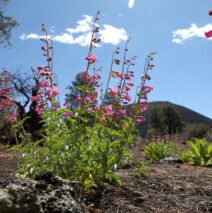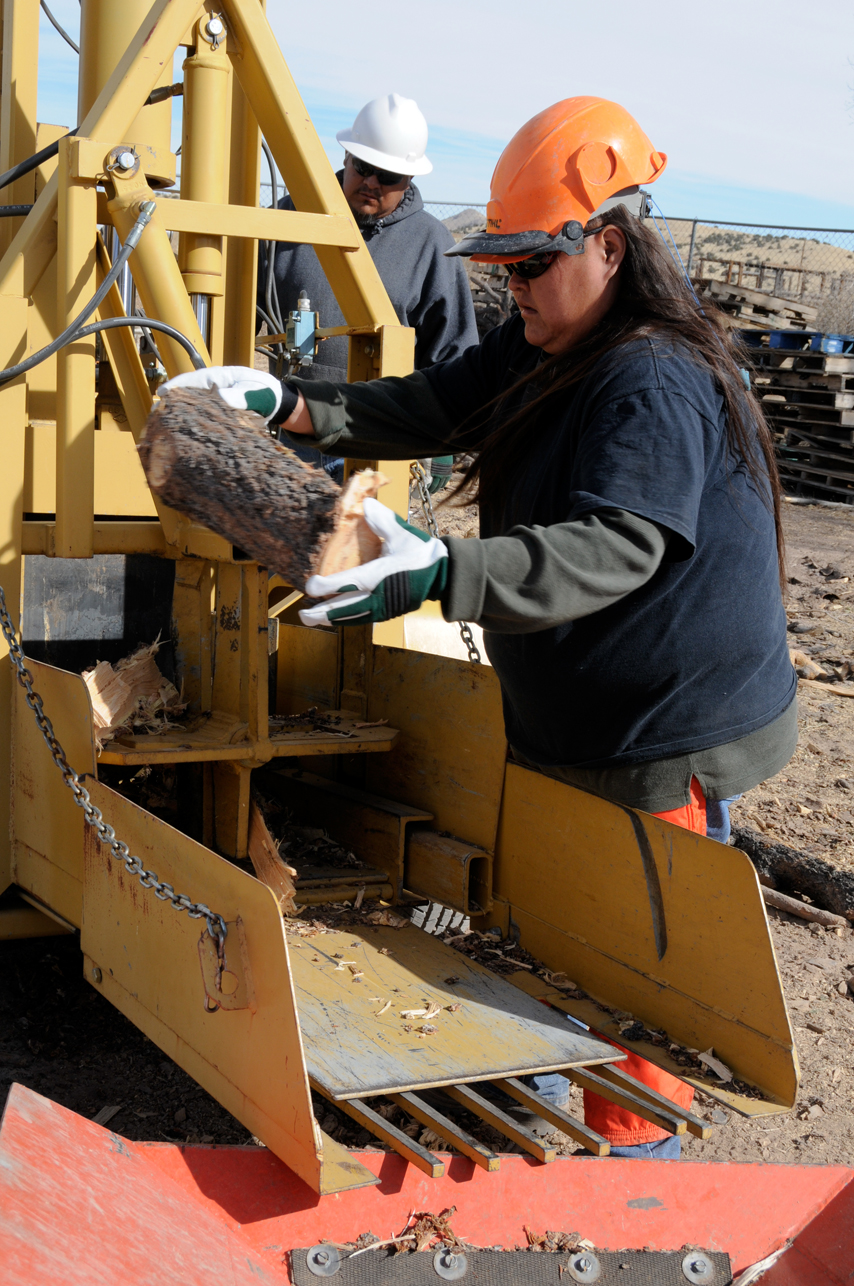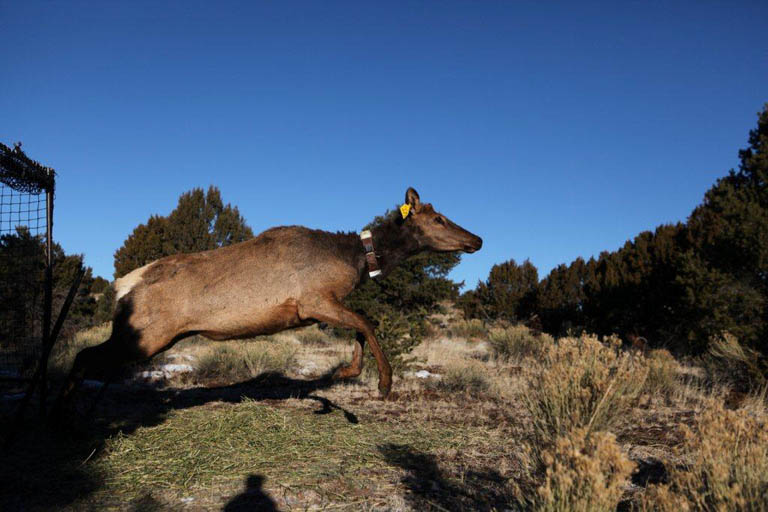Rare Flowers
Wildflowers in bloom are northern Arizona's reward for surviving one of the snowiest winters on record. But one striking hot pink flower growing in one of the harshest environments around has botanists bursting with questions. The hot pink penstemon clutei (pronounced CLUE-tee-eye), also known as the Sunset Crater Beardtongue, has caught the attention of bees, hummingbirds and plant ecologists such as Judy Springer of the Ecological Restoration Institute at Northern Arizona University. "We're interested in doing research on this plant in particular because it only grows here. On the entire planet, the area around Sunset Crater is the only place you'll find it in the wild." A rare find indeed, this penstemon is a striking contrast among the black cinders of a thousand-year-old volcanic eruption. "The volcanic soils act as a mulch," said Springer. "There are cinders on top and then, if you go down a little bit, you'll come to a silty layer where the moisture resides." But the competition for moisture in the cinders is fierce. "We have found that this particular plant is severely impacted by competition," said ERI ecologist Doc Smith. "The large number of ponderosa pine trees that have encroached on this site have affected the beardtongue and its ability to thrive." ERI researchers say the pine forests of the West are unnaturally crowded with thickets of trees because of changes to the landscape since pioneers moved in. Overgrazing by early settlers removed the grasses that once carried frequent, low-intensity wildfires along the forest floor. This, along with fire suppression policies, allowed many small trees to become established and choke out wildflowers like the penstemon clutei. But competition from other plants is not this flower's only threat. It also seems to be a tasty treat for a number of wildlife species. "On a lot of these flowering stems you can see they have been nipped off, probably by deer, elk or rabbits," said Springer. How the Sunset Crater Beardtongue continues to thrive, how it got here and how it reproduces are questions researchers at the ERI are hoping to answer as they study the effects of a changing forest on a pretty plant, answers that may keep a rare and vibrant bloom from permanently fading into the sunset near Sunset Crater. Bonnie Stevens is the Ecological Restoration Institute at Northern Arizona University program director for public education and information. Link to The AZ Daily Sun Story...
Read MoreRadio – KNAU Inquiring Minds
Inquiring Minds Series The two-minute long Inquiring Minds segments will air most Mondays at 6:30 and 8:30 a.m. to provide fascinating insights into the campus of Northern Arizona University. Learn about research into mirror neurons that could actually make people nicer, volcanoes that may one day generate Flagstaff’s electricity, and the world’s only major religion that is now extinct. Listen to the...
Read MoreCutting Edge Jobs
April 15, 2011 Contact: bonnie.stevens@gmail.com For Immediate Release 928-380-4349 Cutting-edge Jobs Supported by Old Wood Flagstaff, Ariz. – Hope for forests and communities at risk is spreading like wildfire in an isolated village south of Albuquerque. Northern Arizona University ecologists say what’s happening on the Alamo Navajo Reservation could well be a model for forest restoration across the Southwest where there are too many trees and not enough jobs. In a small lumberyard in Socorro, N.M., young adults are learning how to cut down trees, operate logging equipment and split firewood. Derek Padilla is the crew leader. “This project is helping me because it’s near my home on the reservation.” The Alamo Navajo Reservation consists of only about 2,000 people. Nearly 70 percent are unemployed and most are living below the national poverty level. Nearby is the Cibola National Forest, unnaturally thick with pinyon and juniper trees. The area is considered New Mexico’s most dangerous place for homes and businesses during fire season. “We’ve removed natural fire from a lot of the ecosystems throughout the West,” says Wally Covington, Arizona’s director for the Southwest Ecological Restoration Institutes and Regents’ Professor. “That has allowed forests to build up these ground fuels and ladder fuels and that’s what we’re trying to deal with across millions of acres. We’re trying to mimic what science tells us would be a more natural condition.” To achieve this desired condition, Covington says a trained labor force and a market for small diameter trees will be essential. In the Alamo Navajo Project, SWERI is providing training along with equipment, such as wood splitters and yarders. The collaboration also includes financial and in-kind assistance from the U.S. Forest Service. “A similar model could help facilitate efforts in northern Arizona where the nation’s largest forest restoration project, the Four Forest Restoration Initiative, is in the planning stages,” says Covington. The 4FRI aims to treat some 2.4 million acres of ponderosa pine across the Mogollon rim during the next 20 years. NAU researchers are providing ecological restoration science findings to the Forest Service to achieve landscape-scale forest health. “We now have people here who are trained in felling, trained in primary processing and trained in restoration monitoring,” says New Mexico’s SWERI Director Andrew Egan. “They are really making New Mexico forests healthier and making New Mexico a safer place to be because we are reducing the impacts of potential wildfires.” With the restoration institutes, the Alamo Navajo School Board has created a wood products program out of trees that nobody wanted. “We sell firewood all over the country,” says the school board’s Natural Resource Specialist Bill Ferranti. “Our biggest market is in west Texas. We shipped some to Chicago. We shipped some to North Carolina. We shipped more than 300 cords last year.” It’s a collaboration supported by Old Wood. Owner David Old is building a business out of sticks and branches in Las Vegas, N.M. “The whole plant is really scaled and geared for making flooring from smaller trees. We are not about cutting down the big trees.” If his idea stacks up, Old will construct a new foundation for some 50 employees in a $2-million-dollar a year operation. Old Wood’s first order for pinyon wood flooring cut by the Alamo Navajo crew is scheduled to go to a San Francisco restaurant. ### Feature...
Read MoreCollars and Corridors
Elk are roaming around the woods with collars around their necks. In the forest near Flagstaff, elk are being outfitted to tell researchers what they and other animals need to navigate through urban sprawl, climate change and large restoration projects. For Arizona Game and Fish Department wildlife biologist Jeff Gagnon, the job of collaring an elk is somewhat like a rodeo event. Within minutes, he and a team of wildlife managers can calm a frightened animal that might weigh as much as a thousand pounds. “We fit the collar to make sure the animal has some space and isn’t being choked,” he says. The collar is programmed to fall off in a few months. But in the meantime, every two hours a GPS unit is sending signals to satellites that are sending signals to biologists. Gagnon has been tracking some 130 elk around major highways including interstates 17 and 40. “We know where the animals are, what kind of habitat they are using and what barriers are stopping them. For a lot of animals when we fragment their habitat, they can’t get to resources like summer or winter range. We also run the risk of isolating or breaking up the herd, which can lead to a smaller gene pool and a weaker species.” Researchers like Northern Arizona University’s Dr. Paul Beier, a conservation biology and wildlife ecology professor in the School of Forestry, says this information is critically important to keep animals from stepping into danger or even extinction. “With climate change, we have the situation where habitat is literally moving out from under the feet of wildlife,” he says. “In order for these species to stay where they are, in terms of a healthy population, they have to move.” Beier is developing maps detailing links for wild areas, or wildlife corridors, to help land managers understand how animals move across the land. “We’re creating landscapes that are more permeable than the landscapes we had a decade or two decades ago,” he says. “If you provide habitat for the large species, you bring the others along,” says Arizona Game and Fish Department Habitat Program Manager Sarah Reif. “Elk, mule deer, pronghorn antelope – these are the big guys we manage for because of public safety on highways and roads, and because they have the biggest home ranges.” Pronghorn have long been a symbol of the West, but researchers say barriers like canals, fences and highways have had a substantial impact on the population. “In Arizona, the numbers declined from about 45,000 animals in the early 1900s to roughly 7,500 in 2002.” says Reif. “Since then we have recovered the population to somewhere around 11,000 but we still have a lot of work to do to connect pronghorn habitats.” With information about wildlife movement, highways are becoming less of a hindrance, and safer for wildlife and people. Groups like the Arizona Department of Transportation, Elk Society, Rocky Mountain Elk Foundation and Federal Highway Administration are funding research and passageways. For example, along State Route 260 near Payson, highway improvement projects have included wildlife crossings. “Animals are using the crossings,” says Gagnon, “and collisions between elk and motorists have been reduced by at least 85 percent.” The Ecological Restoration Institute at NAU’s Executive Director Dr. Wally Covington says managing for wildlife corridors is increasingly important as forests are restored on a landscape scale. “Across hundreds of thousands of acres, natural habitat can be restored. Wildlife can self-regulate. Predator prey dynamics can keep populations in a sustainable, steady state that’s characteristic of the evolutionary environment.” Wearing high-tech necklaces, today’s elk may well...
Read MoreSonic Weapon Successful in Bark Beetle Battle
Forest scientists, desperate to stop the massive devastation from bark beetle infestation, have recruited a powerful and unconventional force to fight this fierce little bug. Santa Fe musician and composer David Dunn is that force. He hears beauty in the beetles’ music and has even released a bark beetle CD, The Sound of Light in Trees. With his help, Northern Arizona University scientists have launched a sonic weapon in the bark beetle battle, and it’s working. So, on a radio in a lab at NAU, Dunn and forest researchers are playing all beetles all the time. “The sound is very similar to just scraping your fingers across the surface of a phonograph record,” says Dunn. “The beetles have grooves in their body parts. They rub them together to create rhythmic, percussive sounds.” Scientists hear this as a symphony of destruction. “They kind of sound like an angry squirrel,” says NAU School of Forestry entomology professor Dr. Rich Hofstetter. “They make clicking and scratching sounds as they chew through the wood or attract mates.” All that racket is going on inside millions of overcrowded and drought-stressed trees across the West. Tired and dehydrated, pine trees can’t create enough resin to push all the bugs out, so creatures the size of a grain of rice are killing entire forests by tunneling through the phloem, or living tissue of the trees. “It takes hundreds of years to build a forest. Ponderosa pines are slow-growing trees. They’re actually really well defended typically, but it can take just weeks, sometimes days, for a tree to die,” says Hofstetter. Ecological Restoration Institute researchers say our pine forests evolved naturally with insects like bark beetles that help decompose weak trees. “Our western forests now are crowded with thin, sickly trees that are competing against each other for nutrients,” says ERI ecologist Mike Stoddard. “With predictions of a warmer, dryer West in the long-term forecast, our unhealthy forests are likely to become even more susceptible to unprecedented insect infestations.” Foot soldiers in the bark beetle battle, Hofstetter and School of Forestry research assistant Reagan McGuire recruited Dunn to help them listen to the trees and record the chatter from the enemy under the bark. “These insects are sensitive to sound,” says Dunn. “Sound is a part of how they go about sensing and organizing their world and we’re interfering with that.” They are interfering by introducing a cacophony of bark beetle sounds. “We use several different species and a combination of aggression and courtship calls,” says Hofstetter. “It’s our hope to confuse them and stop their ability to reproduce.” Using tiny speakers, like the kind you’d find in a musical Hallmark greeting card, the scientists have engaged in sonic warfare, altering the sounds and turning the beetles’ chirping galleries into shrieking chambers of horror. “When we play the sounds, it’s very clear the creatures don’t want to be where they are. They become very agitated. The kinds of behavior that have been induced include tunneling in circles, ignoring each other or tearing each other apart,” says Dunn. “If they can’t go about their normal business, the reproductive cycle collapses.” The scientists invited 28 bark beetle couples to participate in an experiment. Fourteen couples were blasted with the mutated beetle sounds; 14 were not. “The experiment was tremendously successful,” says McGuire. “The control couples produced 200 eggs in tunnels 15 to 30 centimeters long, the kind of tunnel capable of killing a tree. The 14 sound couples produced only one egg collectively and their tunnels were short, only a few centimeters long.” These scientists appear to have struck the right chord with their acoustic chaos. They are working on a patent to produce a product that will protect individual trees without the use of pesticides. Now their...
Read More



